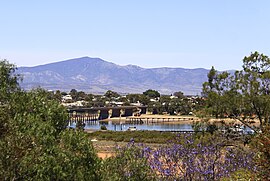Port Augusta
|
Port Augusta South Australia |
|||||||
|---|---|---|---|---|---|---|---|

View across Spencer Gulf to Mount Brown
|
|||||||
| Coordinates | 32°29′33″S 137°45′57″E / 32.49250°S 137.76583°ECoordinates: 32°29′33″S 137°45′57″E / 32.49250°S 137.76583°E | ||||||
| Population | 14,214 (2015) | ||||||
| Established | 1852 | ||||||
| Postcode(s) | 5700 | ||||||
| Location | |||||||
| LGA(s) | City of Port Augusta | ||||||
| State electorate(s) | Stuart | ||||||
| Federal Division(s) | Grey | ||||||
|
|||||||
Port Augusta is a small city in South Australia. It is a seaport and railway junction city mainly located on the east coast of the Spencer Gulf immediately south of the gulf's head and about 322 kilometres (200 mi) north of the state capital. The suburb of Port Augusta West is located on the west side of the gulf on the Eyre Peninsula. Other major industries included, up until mid-2010s, electricity generation. At June 2015, the estimated urban population was 14,214.
The city consists of an urban area extending along the Augusta and Eyre Highways from the coastal plain on the west side of the Flinders Ranges in the east across Spencer Gulf to Eyre Peninsula in the west. The urban area consists of the following suburbs laid out from east to west - Port Augusta and Davenport on the eastern side of Spencer Gulf and Port Augusta West on the Eyre Peninsula.
It is a natural harbour, which was founded on 24 May 1852 by Alexander Elder and John Grainger who selected the location for the port. Mr. Grainger was a member of Government from Adelaide. The port was named after Augusta Sophia, Lady Young, the wife of the Governor of South Australia, Sir Henry Edward Fox Young.
According to the 2011 Census, the population of the Port Augusta census area was 13,504 people, making it the second largest urban area after Whyalla on the Eyre Peninsula. 50.2% of the population were female, 85.2% are Australian born, over 88.6% of residents are Australian citizens and 17.3% were Aboriginal.
The most popular industries for employment were Technicians and Trades Workers (16%), Community and Personal Service Workers (15.4%) and Clerical and Administrative Workers (13.8%), while the unemployment rate is approximately 7%. The median weekly household income is A$789 or more per week, compared with $924 in Adelaide. 17.4% of the population identify themselves as Catholic, while a higher 26.2% identify with no religion at all.
...
Wikipedia

